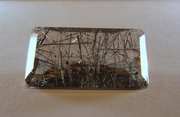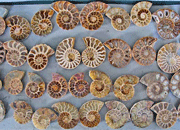 A few gemstones are used as gems in the crystal or other form in which they are found. Most however, are cut and polished for usage as jewelry. The two main classifications are stones cut as smooth, dome shaped stones called cabochons, and stones which are cut with a faceting machine by polishing small flat windows called facets at regular intervals at exact angles.
A few gemstones are used as gems in the crystal or other form in which they are found. Most however, are cut and polished for usage as jewelry. The two main classifications are stones cut as smooth, dome shaped stones called cabochons, and stones which are cut with a faceting machine by polishing small flat windows called facets at regular intervals at exact angles.
Stones which are opaque such as opal, turquoise, variscite, etc. are commonly cut as cabochons. These gems are designed to show the stone's color or surface properties as in opal and star sapphires. Grinding wheels and polishing agents are used to grind, shape and polish the smooth dome shape of the stones.
Gems which are transparent are normally faceted, a method which shows the optical properties of the stone’s interior to its best advantage by maximizing reflected light which is perceived by the viewer as sparkle. There are many commonly used shapes for faceted stones. The facets must be cut at the proper angles, which varies depending on the optical properties of the gem. If the angles are too steep or too shallow, the light will pass through and not be reflected back toward the viewer. Special equipment, a faceting machine, is used to hold the stone onto a flat lap for cutting and polishing the flat facets. Rarely, some cutters use special curved laps to cut and polish curved facets.
Gemstone color
Color is the most obvious and attractive feature of gemstones. The color of any material is due to the nature of light itself. Daylight, often called white light, is actually a mixture of different colors of light. When light passes through a material, some of the light may be absorbed, while the rest passes through. The part that is not absorbed reaches the eye as white light minus the absorbed colors. A ruby appears red because it absorbs all the other colors of white light - blue, yellow, green, etc. - except red.
The same material can exhibit different colors. For example ruby and sapphire have the same chemical composition (both are corundum) but exhibit different colors. Even the same gemstone can occur in many different colors: sapphires show different shades of blue and pink and "fancy sapphires" exhibit a whole range of other colors from yellow to orange-pink, the latter called "Padparadscha sapphire".
This difference in color is based on the atomic structure of the stone. Although the different stones formally have the same chemical composition, they are not exactly the same. Every now and then an atom is replaced by a completely different atom (and this could be as few as one in a million atoms). These so called impurities are sufficient to absorb certain colors and leave the other colors unaffected.
As an example: beryl, which is colorless in its pure mineral form, becomes emerald with chromium impurities. If you add manganese instead of chromium, beryl becomes pink morganite. With iron, it becomes aquamarine.
Some gemstone treatments make use of the fact that these impurities can be "manipulated", thus changing the color of the gem.




